PPDI5039 Project Placement Design and Implementation - Cesim Project
VerifiedAdded on 2023/06/03
|26
|6894
|359
Project
AI Summary
This document details a project focused on developing software for the Cesim project management simulation, centered around document digitization. The aim is to enhance the efficiency of digitization efforts and ensure the quality of digitized documents. The project addresses human and technical challenges, including cost, technical aspects, and long-term preservation. It utilizes a learning contract to automate document handling in a standardized format, setting SMARTER objectives and deadlines. The project incorporates goal-setting theory, develops leadership skills, and manages project complexity involving budget, resource allocation, and problem-solving. Key learning outcomes include building a portfolio of evidence, identifying work-related skills, demonstrating understanding of project context, and evaluating preparation effectiveness. The project uses simulation methods, including a Gantt chart for scheduling, to facilitate teamwork and collaboration, and encourages students to analyze and evaluate information, turning project management theory into real-world application.
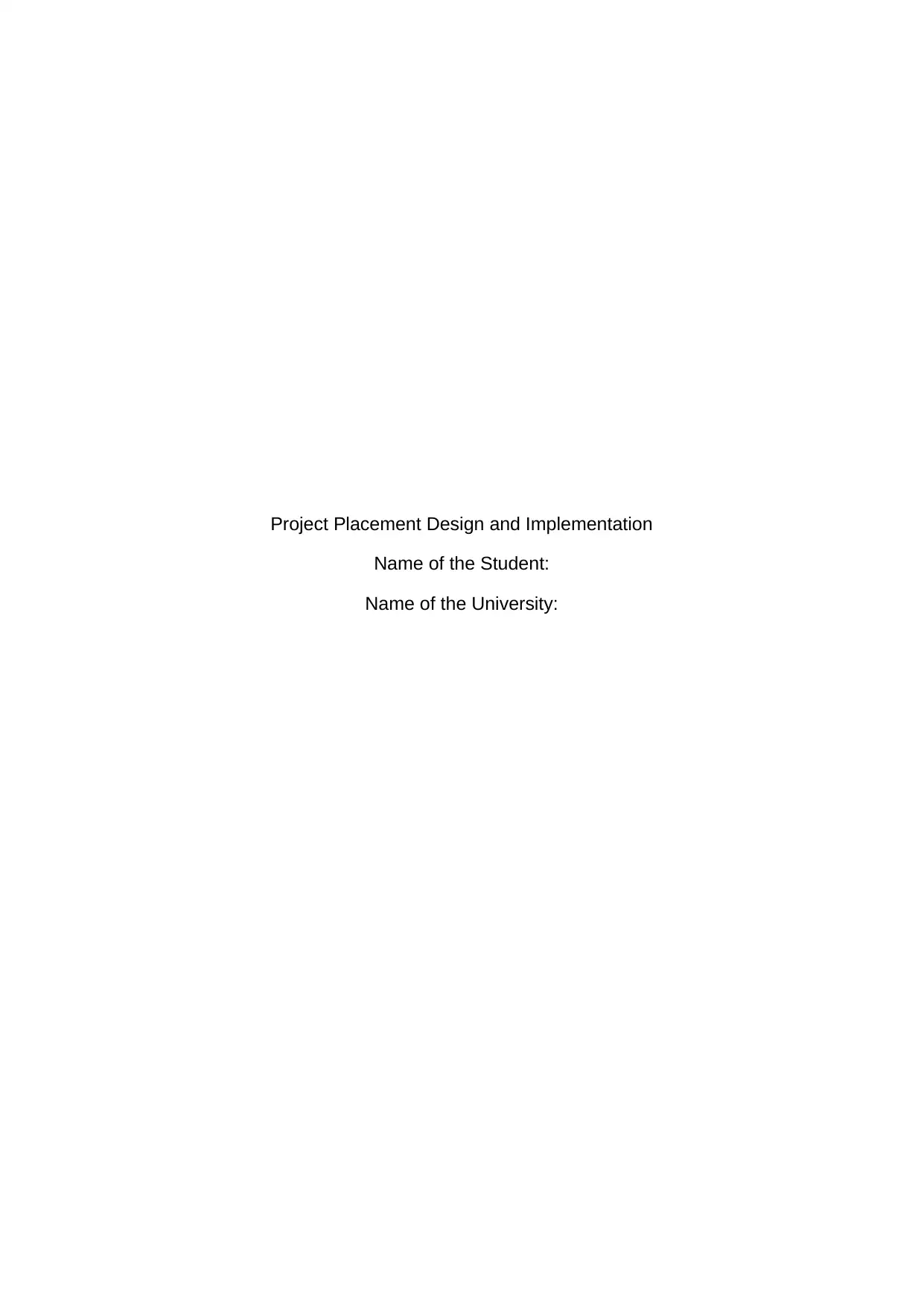
Project Placement Design and Implementation
Name of the Student:
Name of the University:
Name of the Student:
Name of the University:
Paraphrase This Document
Need a fresh take? Get an instant paraphrase of this document with our AI Paraphraser
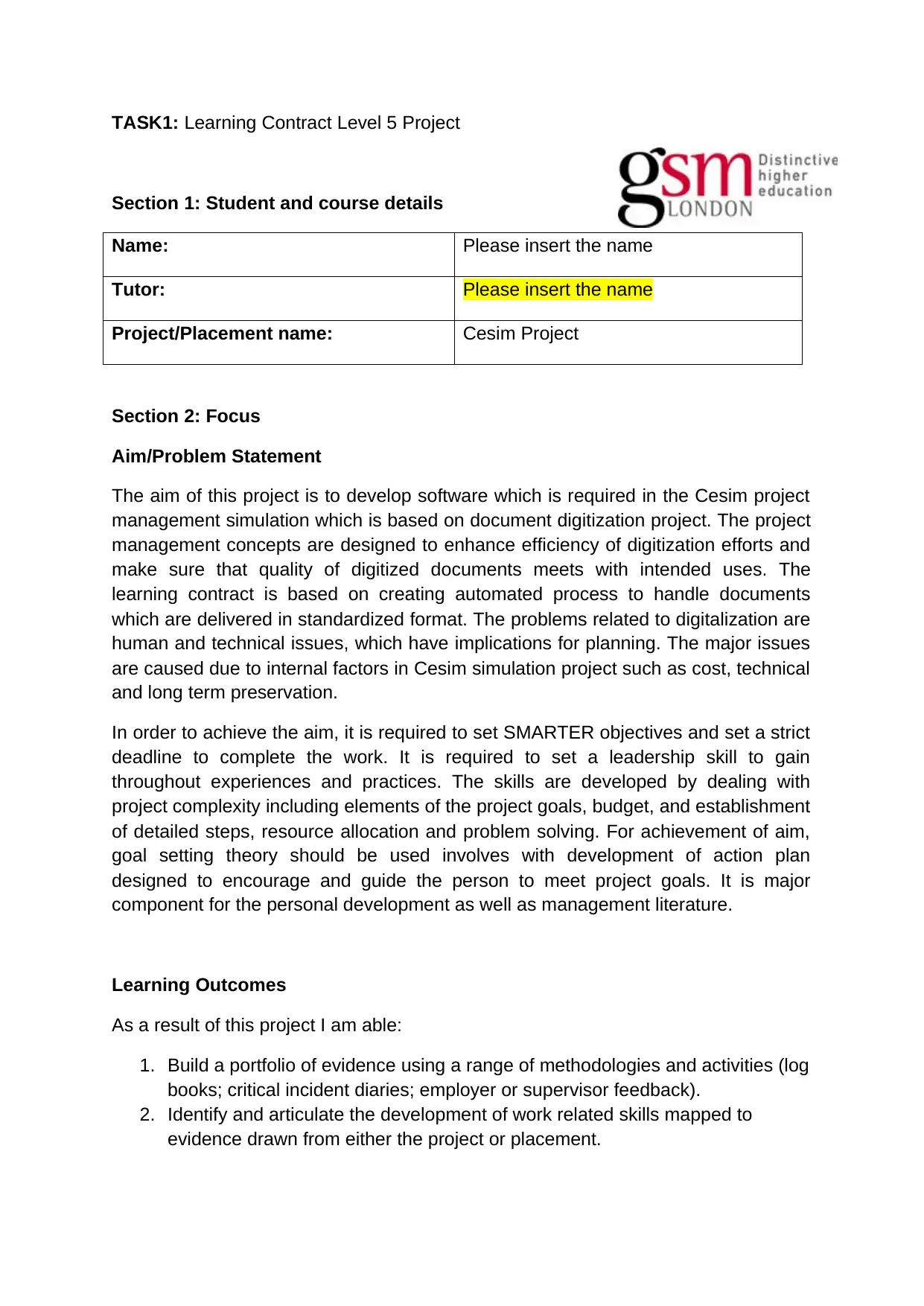
TASK1: Learning Contract Level 5 Project
Section 1: Student and course details
Name: Please insert the name
Tutor: Please insert the name
Project/Placement name: Cesim Project
Section 2: Focus
Aim/Problem Statement
The aim of this project is to develop software which is required in the Cesim project
management simulation which is based on document digitization project. The project
management concepts are designed to enhance efficiency of digitization efforts and
make sure that quality of digitized documents meets with intended uses. The
learning contract is based on creating automated process to handle documents
which are delivered in standardized format. The problems related to digitalization are
human and technical issues, which have implications for planning. The major issues
are caused due to internal factors in Cesim simulation project such as cost, technical
and long term preservation.
In order to achieve the aim, it is required to set SMARTER objectives and set a strict
deadline to complete the work. It is required to set a leadership skill to gain
throughout experiences and practices. The skills are developed by dealing with
project complexity including elements of the project goals, budget, and establishment
of detailed steps, resource allocation and problem solving. For achievement of aim,
goal setting theory should be used involves with development of action plan
designed to encourage and guide the person to meet project goals. It is major
component for the personal development as well as management literature.
Learning Outcomes
As a result of this project I am able:
1. Build a portfolio of evidence using a range of methodologies and activities (log
books; critical incident diaries; employer or supervisor feedback).
2. Identify and articulate the development of work related skills mapped to
evidence drawn from either the project or placement.
Section 1: Student and course details
Name: Please insert the name
Tutor: Please insert the name
Project/Placement name: Cesim Project
Section 2: Focus
Aim/Problem Statement
The aim of this project is to develop software which is required in the Cesim project
management simulation which is based on document digitization project. The project
management concepts are designed to enhance efficiency of digitization efforts and
make sure that quality of digitized documents meets with intended uses. The
learning contract is based on creating automated process to handle documents
which are delivered in standardized format. The problems related to digitalization are
human and technical issues, which have implications for planning. The major issues
are caused due to internal factors in Cesim simulation project such as cost, technical
and long term preservation.
In order to achieve the aim, it is required to set SMARTER objectives and set a strict
deadline to complete the work. It is required to set a leadership skill to gain
throughout experiences and practices. The skills are developed by dealing with
project complexity including elements of the project goals, budget, and establishment
of detailed steps, resource allocation and problem solving. For achievement of aim,
goal setting theory should be used involves with development of action plan
designed to encourage and guide the person to meet project goals. It is major
component for the personal development as well as management literature.
Learning Outcomes
As a result of this project I am able:
1. Build a portfolio of evidence using a range of methodologies and activities (log
books; critical incident diaries; employer or supervisor feedback).
2. Identify and articulate the development of work related skills mapped to
evidence drawn from either the project or placement.
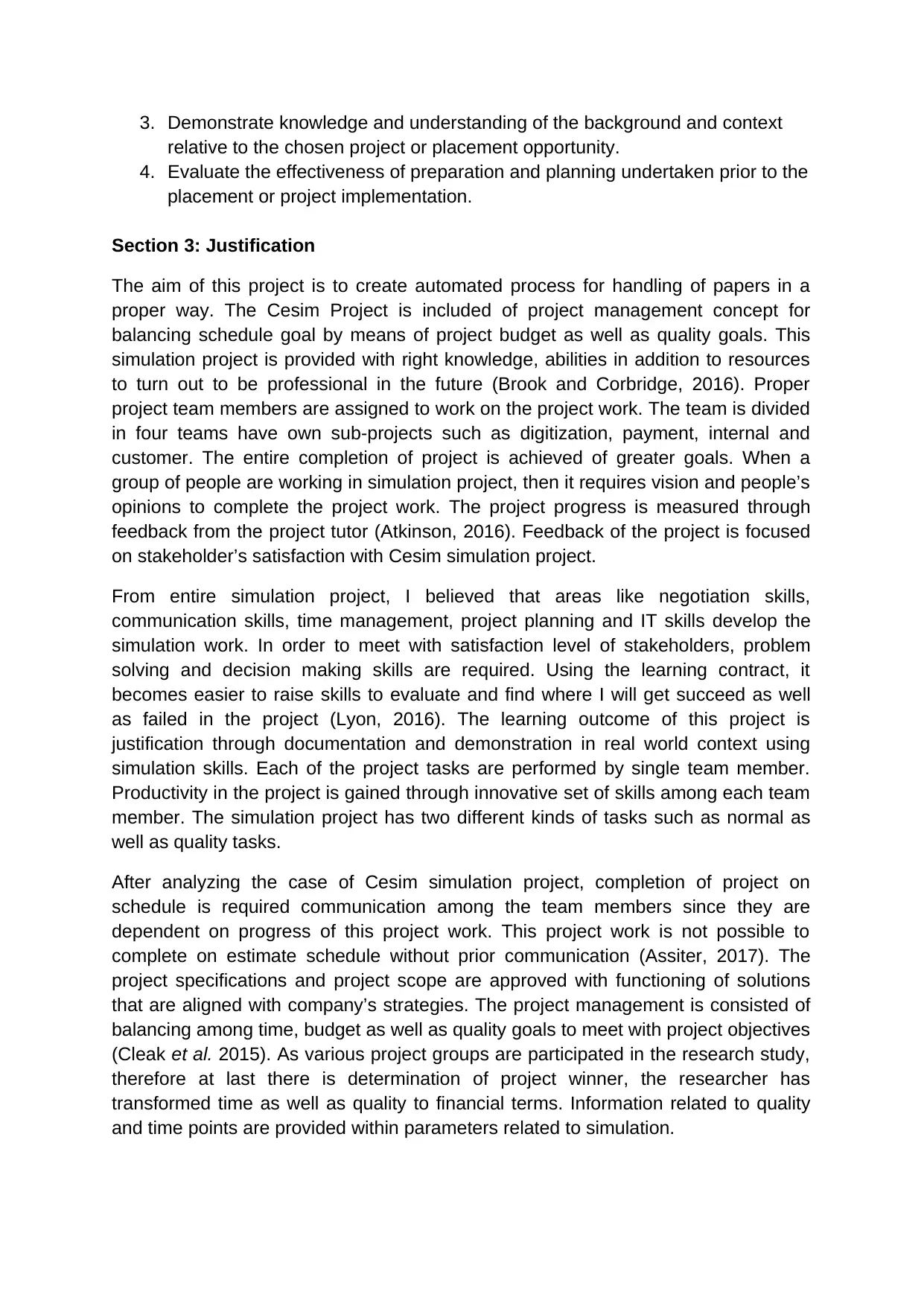
3. Demonstrate knowledge and understanding of the background and context
relative to the chosen project or placement opportunity.
4. Evaluate the effectiveness of preparation and planning undertaken prior to the
placement or project implementation.
Section 3: Justification
The aim of this project is to create automated process for handling of papers in a
proper way. The Cesim Project is included of project management concept for
balancing schedule goal by means of project budget as well as quality goals. This
simulation project is provided with right knowledge, abilities in addition to resources
to turn out to be professional in the future (Brook and Corbridge, 2016). Proper
project team members are assigned to work on the project work. The team is divided
in four teams have own sub-projects such as digitization, payment, internal and
customer. The entire completion of project is achieved of greater goals. When a
group of people are working in simulation project, then it requires vision and people’s
opinions to complete the project work. The project progress is measured through
feedback from the project tutor (Atkinson, 2016). Feedback of the project is focused
on stakeholder’s satisfaction with Cesim simulation project.
From entire simulation project, I believed that areas like negotiation skills,
communication skills, time management, project planning and IT skills develop the
simulation work. In order to meet with satisfaction level of stakeholders, problem
solving and decision making skills are required. Using the learning contract, it
becomes easier to raise skills to evaluate and find where I will get succeed as well
as failed in the project (Lyon, 2016). The learning outcome of this project is
justification through documentation and demonstration in real world context using
simulation skills. Each of the project tasks are performed by single team member.
Productivity in the project is gained through innovative set of skills among each team
member. The simulation project has two different kinds of tasks such as normal as
well as quality tasks.
After analyzing the case of Cesim simulation project, completion of project on
schedule is required communication among the team members since they are
dependent on progress of this project work. This project work is not possible to
complete on estimate schedule without prior communication (Assiter, 2017). The
project specifications and project scope are approved with functioning of solutions
that are aligned with company’s strategies. The project management is consisted of
balancing among time, budget as well as quality goals to meet with project objectives
(Cleak et al. 2015). As various project groups are participated in the research study,
therefore at last there is determination of project winner, the researcher has
transformed time as well as quality to financial terms. Information related to quality
and time points are provided within parameters related to simulation.
relative to the chosen project or placement opportunity.
4. Evaluate the effectiveness of preparation and planning undertaken prior to the
placement or project implementation.
Section 3: Justification
The aim of this project is to create automated process for handling of papers in a
proper way. The Cesim Project is included of project management concept for
balancing schedule goal by means of project budget as well as quality goals. This
simulation project is provided with right knowledge, abilities in addition to resources
to turn out to be professional in the future (Brook and Corbridge, 2016). Proper
project team members are assigned to work on the project work. The team is divided
in four teams have own sub-projects such as digitization, payment, internal and
customer. The entire completion of project is achieved of greater goals. When a
group of people are working in simulation project, then it requires vision and people’s
opinions to complete the project work. The project progress is measured through
feedback from the project tutor (Atkinson, 2016). Feedback of the project is focused
on stakeholder’s satisfaction with Cesim simulation project.
From entire simulation project, I believed that areas like negotiation skills,
communication skills, time management, project planning and IT skills develop the
simulation work. In order to meet with satisfaction level of stakeholders, problem
solving and decision making skills are required. Using the learning contract, it
becomes easier to raise skills to evaluate and find where I will get succeed as well
as failed in the project (Lyon, 2016). The learning outcome of this project is
justification through documentation and demonstration in real world context using
simulation skills. Each of the project tasks are performed by single team member.
Productivity in the project is gained through innovative set of skills among each team
member. The simulation project has two different kinds of tasks such as normal as
well as quality tasks.
After analyzing the case of Cesim simulation project, completion of project on
schedule is required communication among the team members since they are
dependent on progress of this project work. This project work is not possible to
complete on estimate schedule without prior communication (Assiter, 2017). The
project specifications and project scope are approved with functioning of solutions
that are aligned with company’s strategies. The project management is consisted of
balancing among time, budget as well as quality goals to meet with project objectives
(Cleak et al. 2015). As various project groups are participated in the research study,
therefore at last there is determination of project winner, the researcher has
transformed time as well as quality to financial terms. Information related to quality
and time points are provided within parameters related to simulation.
⊘ This is a preview!⊘
Do you want full access?
Subscribe today to unlock all pages.

Trusted by 1+ million students worldwide
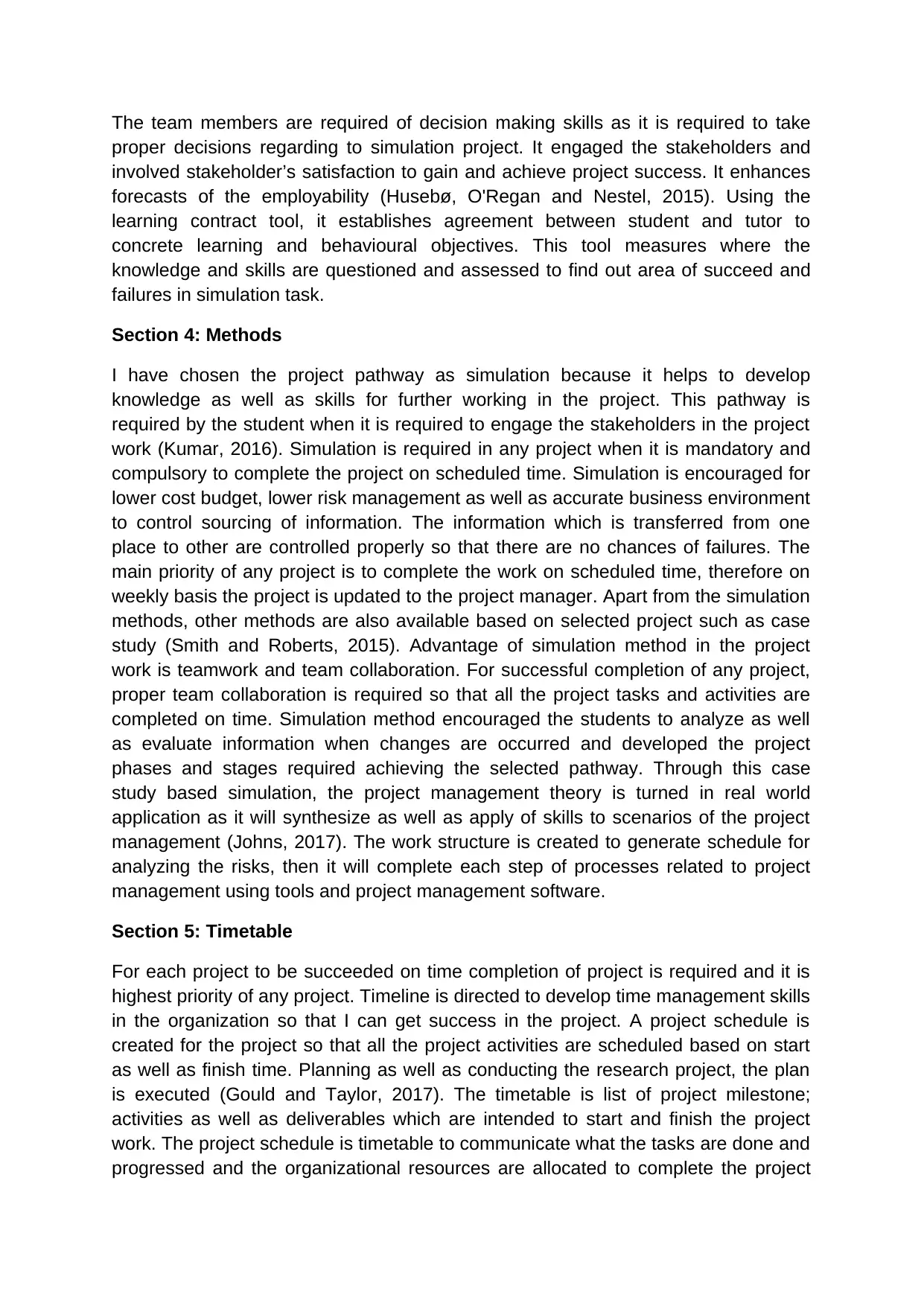
The team members are required of decision making skills as it is required to take
proper decisions regarding to simulation project. It engaged the stakeholders and
involved stakeholder’s satisfaction to gain and achieve project success. It enhances
forecasts of the employability (Husebø, O'Regan and Nestel, 2015). Using the
learning contract tool, it establishes agreement between student and tutor to
concrete learning and behavioural objectives. This tool measures where the
knowledge and skills are questioned and assessed to find out area of succeed and
failures in simulation task.
Section 4: Methods
I have chosen the project pathway as simulation because it helps to develop
knowledge as well as skills for further working in the project. This pathway is
required by the student when it is required to engage the stakeholders in the project
work (Kumar, 2016). Simulation is required in any project when it is mandatory and
compulsory to complete the project on scheduled time. Simulation is encouraged for
lower cost budget, lower risk management as well as accurate business environment
to control sourcing of information. The information which is transferred from one
place to other are controlled properly so that there are no chances of failures. The
main priority of any project is to complete the work on scheduled time, therefore on
weekly basis the project is updated to the project manager. Apart from the simulation
methods, other methods are also available based on selected project such as case
study (Smith and Roberts, 2015). Advantage of simulation method in the project
work is teamwork and team collaboration. For successful completion of any project,
proper team collaboration is required so that all the project tasks and activities are
completed on time. Simulation method encouraged the students to analyze as well
as evaluate information when changes are occurred and developed the project
phases and stages required achieving the selected pathway. Through this case
study based simulation, the project management theory is turned in real world
application as it will synthesize as well as apply of skills to scenarios of the project
management (Johns, 2017). The work structure is created to generate schedule for
analyzing the risks, then it will complete each step of processes related to project
management using tools and project management software.
Section 5: Timetable
For each project to be succeeded on time completion of project is required and it is
highest priority of any project. Timeline is directed to develop time management skills
in the organization so that I can get success in the project. A project schedule is
created for the project so that all the project activities are scheduled based on start
as well as finish time. Planning as well as conducting the research project, the plan
is executed (Gould and Taylor, 2017). The timetable is list of project milestone;
activities as well as deliverables which are intended to start and finish the project
work. The project schedule is timetable to communicate what the tasks are done and
progressed and the organizational resources are allocated to complete the project
proper decisions regarding to simulation project. It engaged the stakeholders and
involved stakeholder’s satisfaction to gain and achieve project success. It enhances
forecasts of the employability (Husebø, O'Regan and Nestel, 2015). Using the
learning contract tool, it establishes agreement between student and tutor to
concrete learning and behavioural objectives. This tool measures where the
knowledge and skills are questioned and assessed to find out area of succeed and
failures in simulation task.
Section 4: Methods
I have chosen the project pathway as simulation because it helps to develop
knowledge as well as skills for further working in the project. This pathway is
required by the student when it is required to engage the stakeholders in the project
work (Kumar, 2016). Simulation is required in any project when it is mandatory and
compulsory to complete the project on scheduled time. Simulation is encouraged for
lower cost budget, lower risk management as well as accurate business environment
to control sourcing of information. The information which is transferred from one
place to other are controlled properly so that there are no chances of failures. The
main priority of any project is to complete the work on scheduled time, therefore on
weekly basis the project is updated to the project manager. Apart from the simulation
methods, other methods are also available based on selected project such as case
study (Smith and Roberts, 2015). Advantage of simulation method in the project
work is teamwork and team collaboration. For successful completion of any project,
proper team collaboration is required so that all the project tasks and activities are
completed on time. Simulation method encouraged the students to analyze as well
as evaluate information when changes are occurred and developed the project
phases and stages required achieving the selected pathway. Through this case
study based simulation, the project management theory is turned in real world
application as it will synthesize as well as apply of skills to scenarios of the project
management (Johns, 2017). The work structure is created to generate schedule for
analyzing the risks, then it will complete each step of processes related to project
management using tools and project management software.
Section 5: Timetable
For each project to be succeeded on time completion of project is required and it is
highest priority of any project. Timeline is directed to develop time management skills
in the organization so that I can get success in the project. A project schedule is
created for the project so that all the project activities are scheduled based on start
as well as finish time. Planning as well as conducting the research project, the plan
is executed (Gould and Taylor, 2017). The timetable is list of project milestone;
activities as well as deliverables which are intended to start and finish the project
work. The project schedule is timetable to communicate what the tasks are done and
progressed and the organizational resources are allocated to complete the project
Paraphrase This Document
Need a fresh take? Get an instant paraphrase of this document with our AI Paraphraser
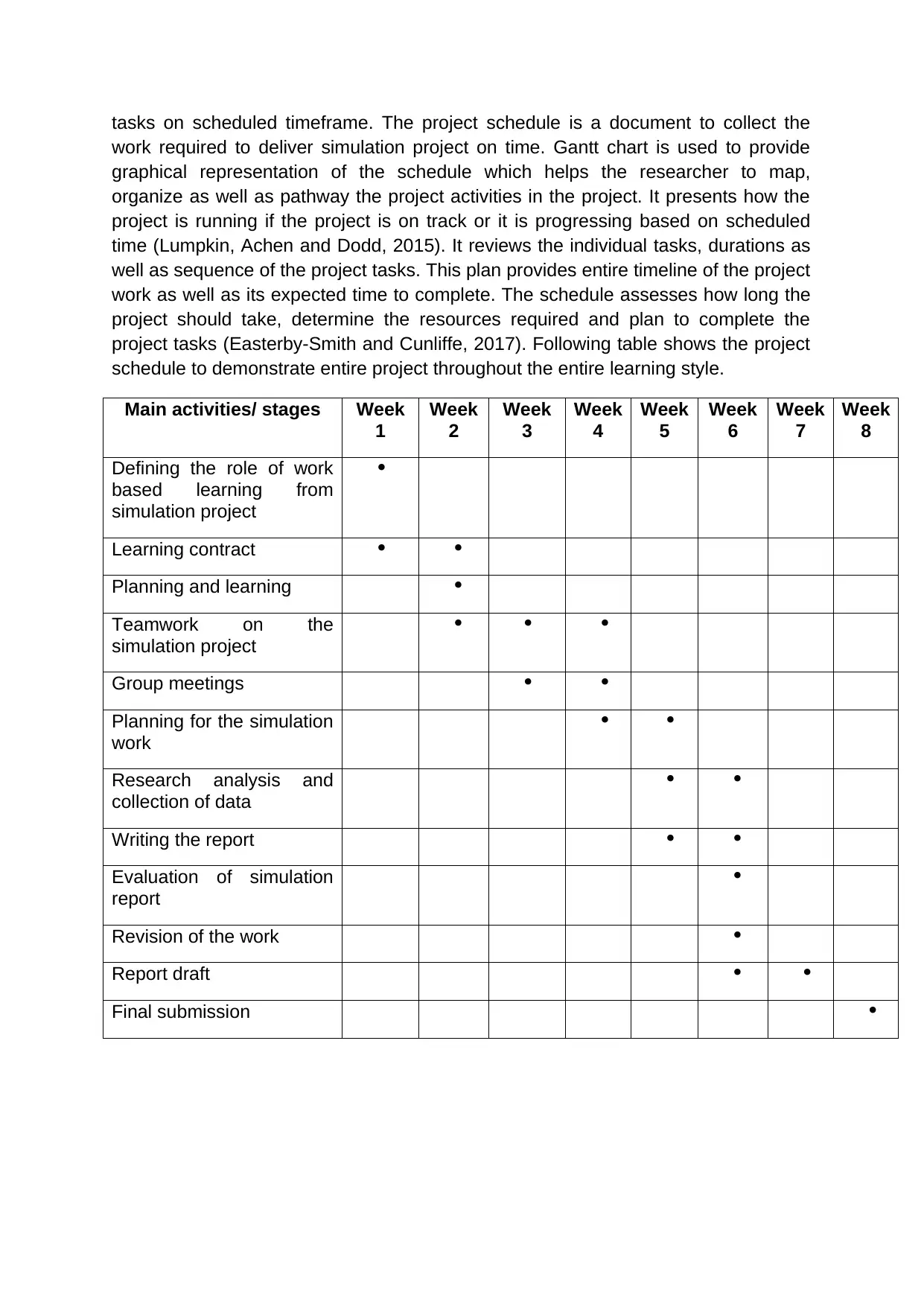
tasks on scheduled timeframe. The project schedule is a document to collect the
work required to deliver simulation project on time. Gantt chart is used to provide
graphical representation of the schedule which helps the researcher to map,
organize as well as pathway the project activities in the project. It presents how the
project is running if the project is on track or it is progressing based on scheduled
time (Lumpkin, Achen and Dodd, 2015). It reviews the individual tasks, durations as
well as sequence of the project tasks. This plan provides entire timeline of the project
work as well as its expected time to complete. The schedule assesses how long the
project should take, determine the resources required and plan to complete the
project tasks (Easterby-Smith and Cunliffe, 2017). Following table shows the project
schedule to demonstrate entire project throughout the entire learning style.
Main activities/ stages Week
1
Week
2
Week
3
Week
4
Week
5
Week
6
Week
7
Week
8
Defining the role of work
based learning from
simulation project
Learning contract
Planning and learning
Teamwork on the
simulation project
Group meetings
Planning for the simulation
work
Research analysis and
collection of data
Writing the report
Evaluation of simulation
report
Revision of the work
Report draft
Final submission
work required to deliver simulation project on time. Gantt chart is used to provide
graphical representation of the schedule which helps the researcher to map,
organize as well as pathway the project activities in the project. It presents how the
project is running if the project is on track or it is progressing based on scheduled
time (Lumpkin, Achen and Dodd, 2015). It reviews the individual tasks, durations as
well as sequence of the project tasks. This plan provides entire timeline of the project
work as well as its expected time to complete. The schedule assesses how long the
project should take, determine the resources required and plan to complete the
project tasks (Easterby-Smith and Cunliffe, 2017). Following table shows the project
schedule to demonstrate entire project throughout the entire learning style.
Main activities/ stages Week
1
Week
2
Week
3
Week
4
Week
5
Week
6
Week
7
Week
8
Defining the role of work
based learning from
simulation project
Learning contract
Planning and learning
Teamwork on the
simulation project
Group meetings
Planning for the simulation
work
Research analysis and
collection of data
Writing the report
Evaluation of simulation
report
Revision of the work
Report draft
Final submission
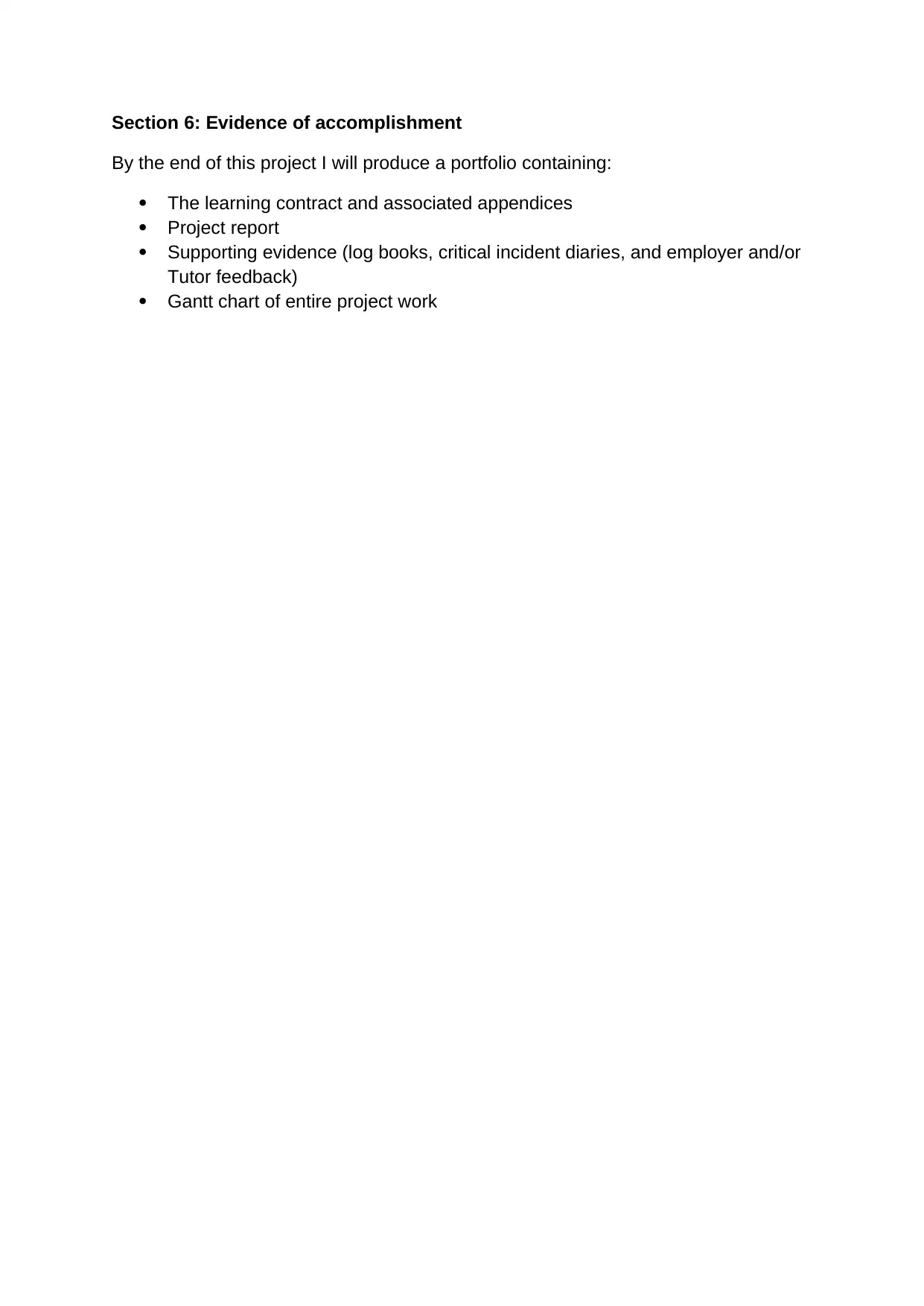
Section 6: Evidence of accomplishment
By the end of this project I will produce a portfolio containing:
The learning contract and associated appendices
Project report
Supporting evidence (log books, critical incident diaries, and employer and/or
Tutor feedback)
Gantt chart of entire project work
By the end of this project I will produce a portfolio containing:
The learning contract and associated appendices
Project report
Supporting evidence (log books, critical incident diaries, and employer and/or
Tutor feedback)
Gantt chart of entire project work
⊘ This is a preview!⊘
Do you want full access?
Subscribe today to unlock all pages.

Trusted by 1+ million students worldwide
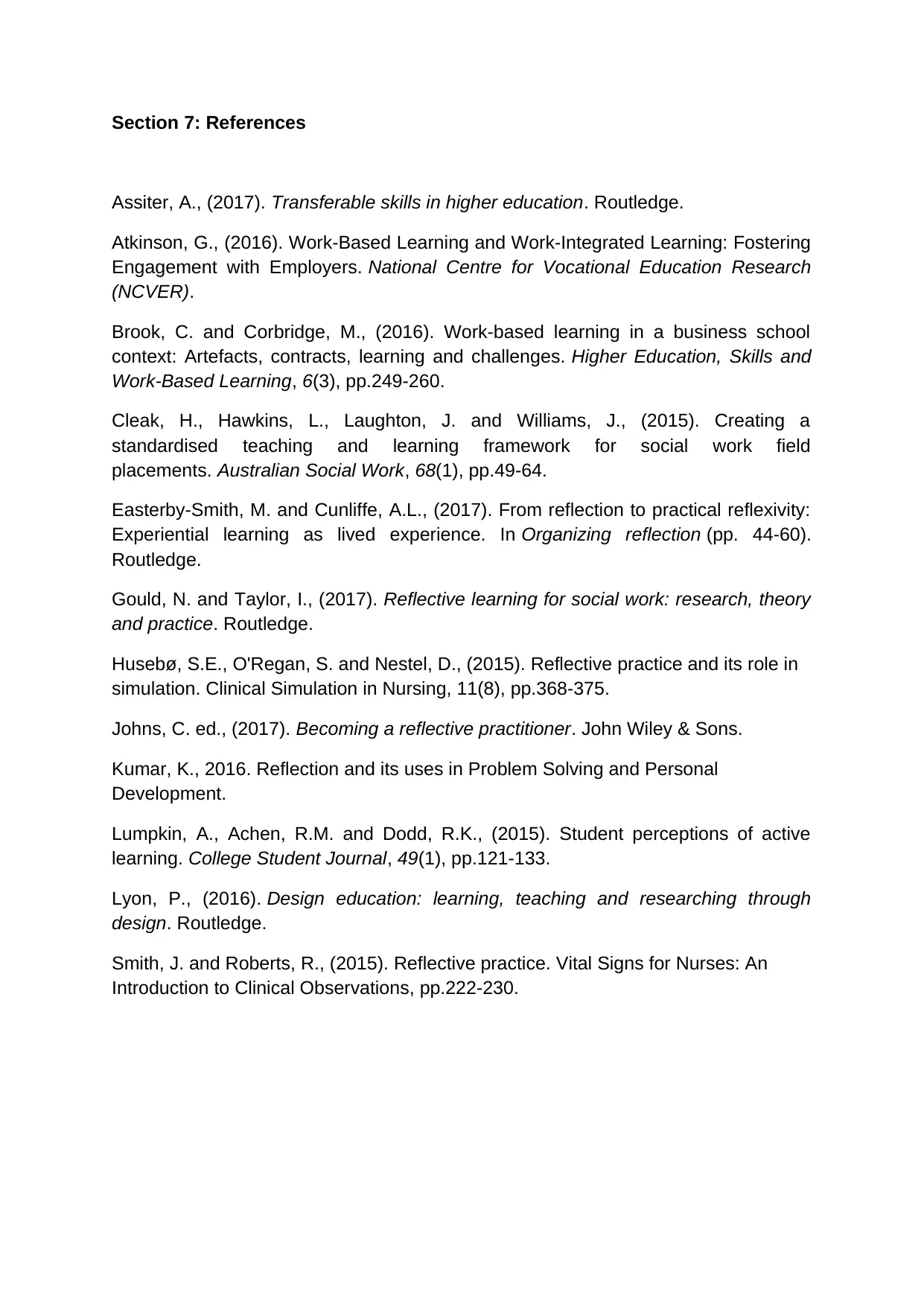
Section 7: References
Assiter, A., (2017). Transferable skills in higher education. Routledge.
Atkinson, G., (2016). Work-Based Learning and Work-Integrated Learning: Fostering
Engagement with Employers. National Centre for Vocational Education Research
(NCVER).
Brook, C. and Corbridge, M., (2016). Work-based learning in a business school
context: Artefacts, contracts, learning and challenges. Higher Education, Skills and
Work-Based Learning, 6(3), pp.249-260.
Cleak, H., Hawkins, L., Laughton, J. and Williams, J., (2015). Creating a
standardised teaching and learning framework for social work field
placements. Australian Social Work, 68(1), pp.49-64.
Easterby-Smith, M. and Cunliffe, A.L., (2017). From reflection to practical reflexivity:
Experiential learning as lived experience. In Organizing reflection (pp. 44-60).
Routledge.
Gould, N. and Taylor, I., (2017). Reflective learning for social work: research, theory
and practice. Routledge.
Husebø, S.E., O'Regan, S. and Nestel, D., (2015). Reflective practice and its role in
simulation. Clinical Simulation in Nursing, 11(8), pp.368-375.
Johns, C. ed., (2017). Becoming a reflective practitioner. John Wiley & Sons.
Kumar, K., 2016. Reflection and its uses in Problem Solving and Personal
Development.
Lumpkin, A., Achen, R.M. and Dodd, R.K., (2015). Student perceptions of active
learning. College Student Journal, 49(1), pp.121-133.
Lyon, P., (2016). Design education: learning, teaching and researching through
design. Routledge.
Smith, J. and Roberts, R., (2015). Reflective practice. Vital Signs for Nurses: An
Introduction to Clinical Observations, pp.222-230.
Assiter, A., (2017). Transferable skills in higher education. Routledge.
Atkinson, G., (2016). Work-Based Learning and Work-Integrated Learning: Fostering
Engagement with Employers. National Centre for Vocational Education Research
(NCVER).
Brook, C. and Corbridge, M., (2016). Work-based learning in a business school
context: Artefacts, contracts, learning and challenges. Higher Education, Skills and
Work-Based Learning, 6(3), pp.249-260.
Cleak, H., Hawkins, L., Laughton, J. and Williams, J., (2015). Creating a
standardised teaching and learning framework for social work field
placements. Australian Social Work, 68(1), pp.49-64.
Easterby-Smith, M. and Cunliffe, A.L., (2017). From reflection to practical reflexivity:
Experiential learning as lived experience. In Organizing reflection (pp. 44-60).
Routledge.
Gould, N. and Taylor, I., (2017). Reflective learning for social work: research, theory
and practice. Routledge.
Husebø, S.E., O'Regan, S. and Nestel, D., (2015). Reflective practice and its role in
simulation. Clinical Simulation in Nursing, 11(8), pp.368-375.
Johns, C. ed., (2017). Becoming a reflective practitioner. John Wiley & Sons.
Kumar, K., 2016. Reflection and its uses in Problem Solving and Personal
Development.
Lumpkin, A., Achen, R.M. and Dodd, R.K., (2015). Student perceptions of active
learning. College Student Journal, 49(1), pp.121-133.
Lyon, P., (2016). Design education: learning, teaching and researching through
design. Routledge.
Smith, J. and Roberts, R., (2015). Reflective practice. Vital Signs for Nurses: An
Introduction to Clinical Observations, pp.222-230.
Paraphrase This Document
Need a fresh take? Get an instant paraphrase of this document with our AI Paraphraser
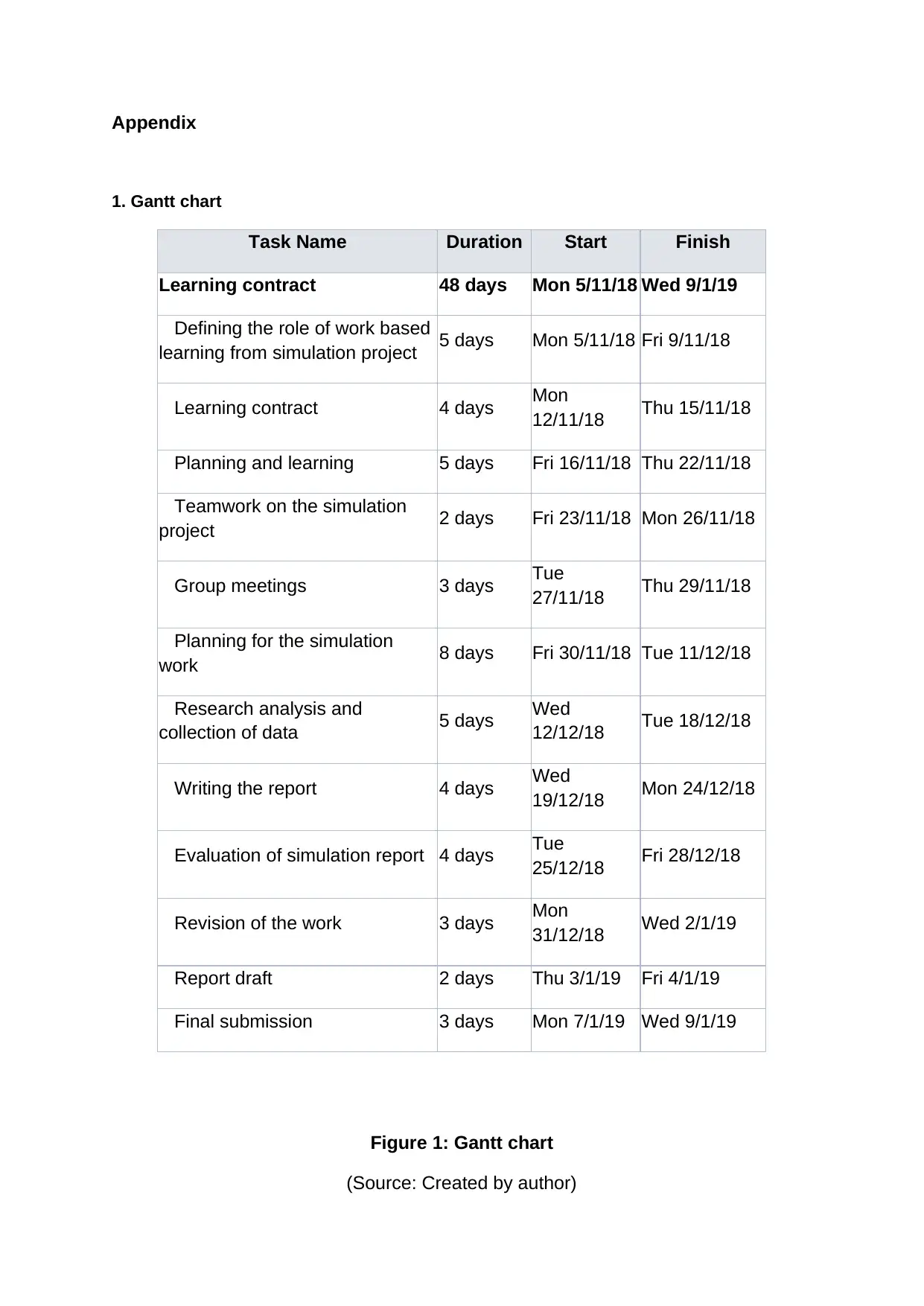
Appendix
1. Gantt chart
Task Name Duration Start Finish
Learning contract 48 days Mon 5/11/18 Wed 9/1/19
Defining the role of work based
learning from simulation project 5 days Mon 5/11/18 Fri 9/11/18
Learning contract 4 days Mon
12/11/18 Thu 15/11/18
Planning and learning 5 days Fri 16/11/18 Thu 22/11/18
Teamwork on the simulation
project 2 days Fri 23/11/18 Mon 26/11/18
Group meetings 3 days Tue
27/11/18 Thu 29/11/18
Planning for the simulation
work 8 days Fri 30/11/18 Tue 11/12/18
Research analysis and
collection of data 5 days Wed
12/12/18 Tue 18/12/18
Writing the report 4 days Wed
19/12/18 Mon 24/12/18
Evaluation of simulation report 4 days Tue
25/12/18 Fri 28/12/18
Revision of the work 3 days Mon
31/12/18 Wed 2/1/19
Report draft 2 days Thu 3/1/19 Fri 4/1/19
Final submission 3 days Mon 7/1/19 Wed 9/1/19
Figure 1: Gantt chart
(Source: Created by author)
1. Gantt chart
Task Name Duration Start Finish
Learning contract 48 days Mon 5/11/18 Wed 9/1/19
Defining the role of work based
learning from simulation project 5 days Mon 5/11/18 Fri 9/11/18
Learning contract 4 days Mon
12/11/18 Thu 15/11/18
Planning and learning 5 days Fri 16/11/18 Thu 22/11/18
Teamwork on the simulation
project 2 days Fri 23/11/18 Mon 26/11/18
Group meetings 3 days Tue
27/11/18 Thu 29/11/18
Planning for the simulation
work 8 days Fri 30/11/18 Tue 11/12/18
Research analysis and
collection of data 5 days Wed
12/12/18 Tue 18/12/18
Writing the report 4 days Wed
19/12/18 Mon 24/12/18
Evaluation of simulation report 4 days Tue
25/12/18 Fri 28/12/18
Revision of the work 3 days Mon
31/12/18 Wed 2/1/19
Report draft 2 days Thu 3/1/19 Fri 4/1/19
Final submission 3 days Mon 7/1/19 Wed 9/1/19
Figure 1: Gantt chart
(Source: Created by author)
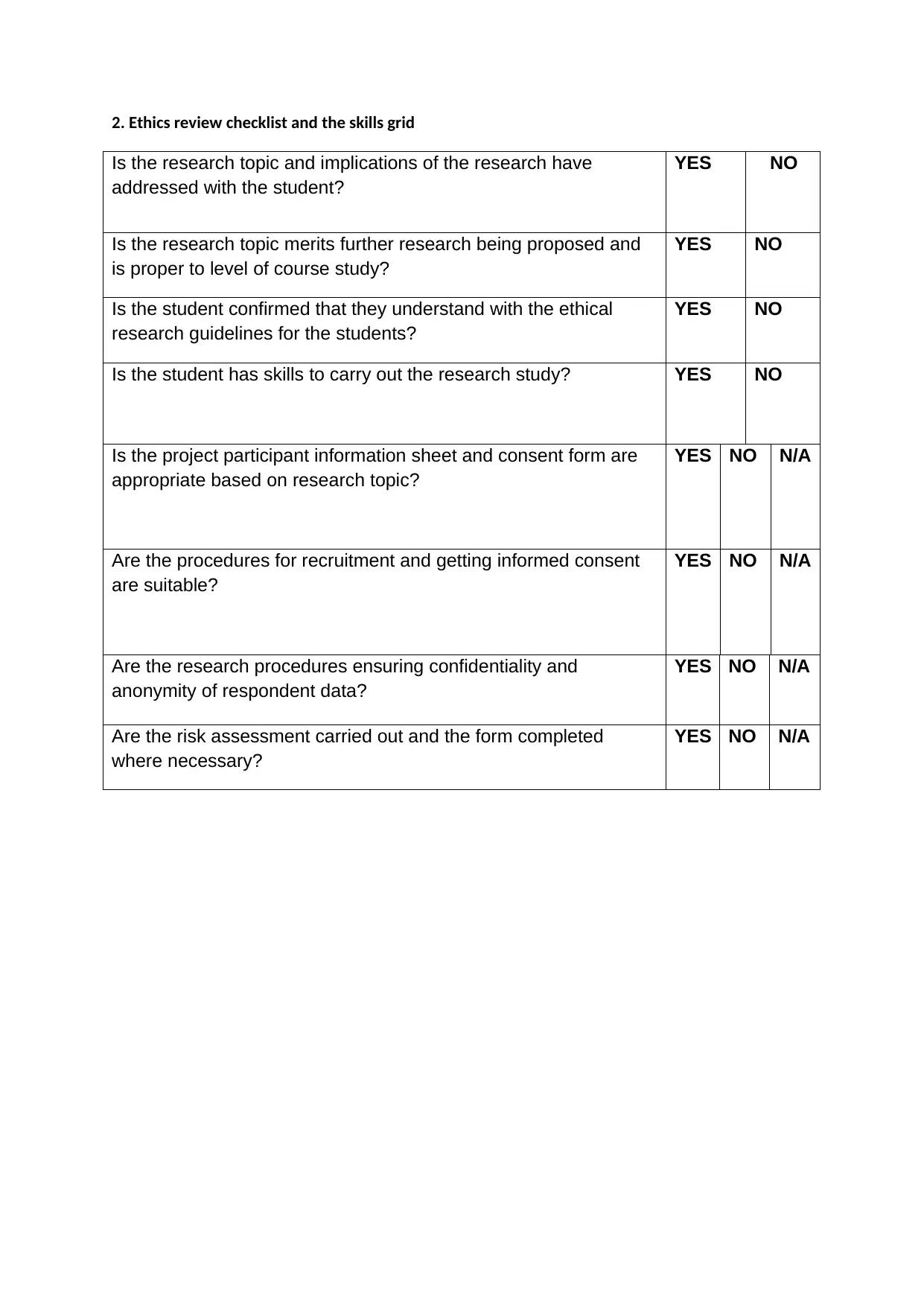
2. Ethics review checklist and the skills grid
Is the research topic and implications of the research have
addressed with the student?
YES NO
Is the research topic merits further research being proposed and
is proper to level of course study?
YES NO
Is the student confirmed that they understand with the ethical
research guidelines for the students?
YES NO
Is the student has skills to carry out the research study? YES NO
Is the project participant information sheet and consent form are
appropriate based on research topic?
YES NO N/A
Are the procedures for recruitment and getting informed consent
are suitable?
YES NO N/A
Are the research procedures ensuring confidentiality and
anonymity of respondent data?
YES NO N/A
Are the risk assessment carried out and the form completed
where necessary?
YES NO N/A
Is the research topic and implications of the research have
addressed with the student?
YES NO
Is the research topic merits further research being proposed and
is proper to level of course study?
YES NO
Is the student confirmed that they understand with the ethical
research guidelines for the students?
YES NO
Is the student has skills to carry out the research study? YES NO
Is the project participant information sheet and consent form are
appropriate based on research topic?
YES NO N/A
Are the procedures for recruitment and getting informed consent
are suitable?
YES NO N/A
Are the research procedures ensuring confidentiality and
anonymity of respondent data?
YES NO N/A
Are the risk assessment carried out and the form completed
where necessary?
YES NO N/A
⊘ This is a preview!⊘
Do you want full access?
Subscribe today to unlock all pages.

Trusted by 1+ million students worldwide
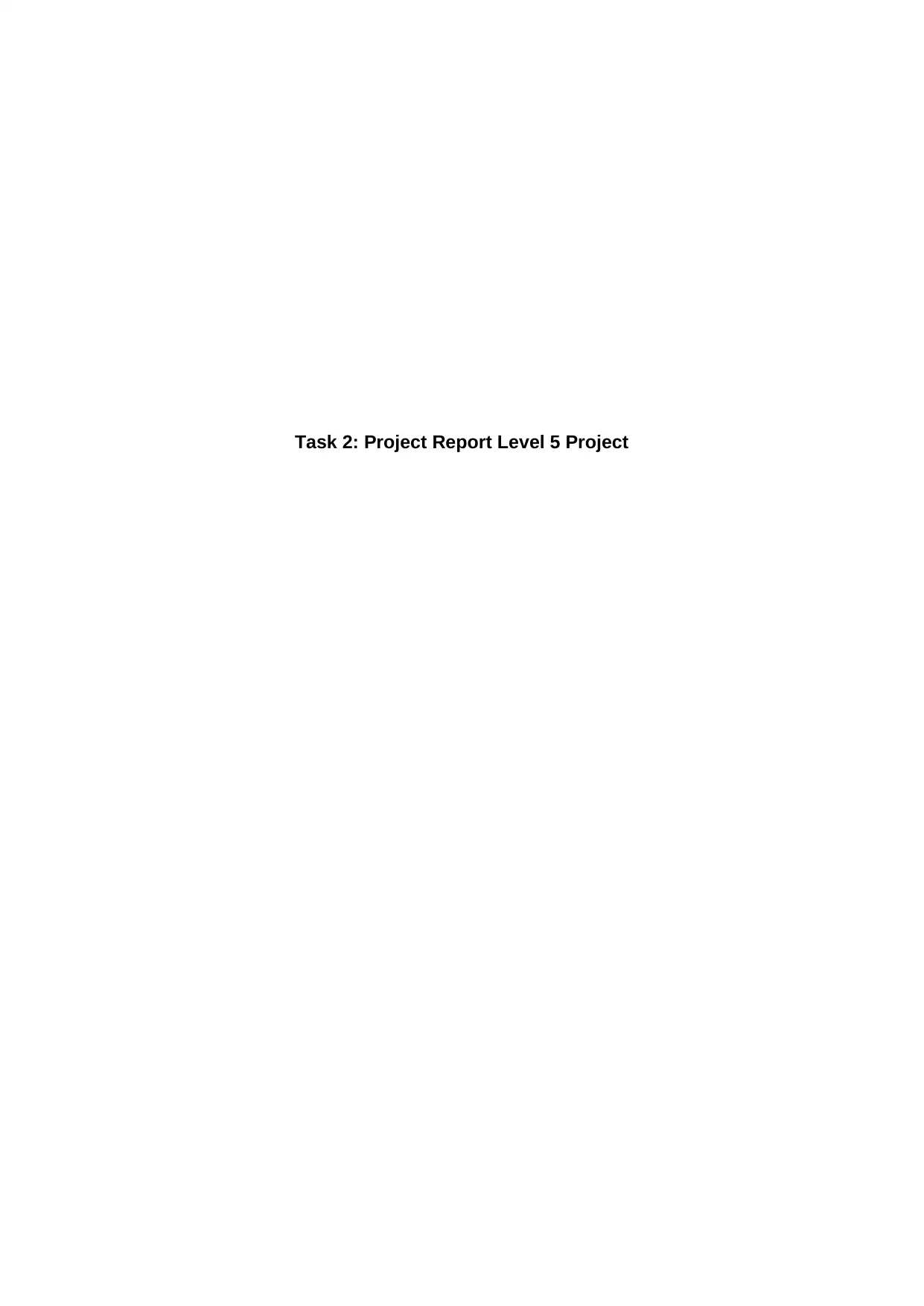
Task 2: Project Report Level 5 Project
Paraphrase This Document
Need a fresh take? Get an instant paraphrase of this document with our AI Paraphraser
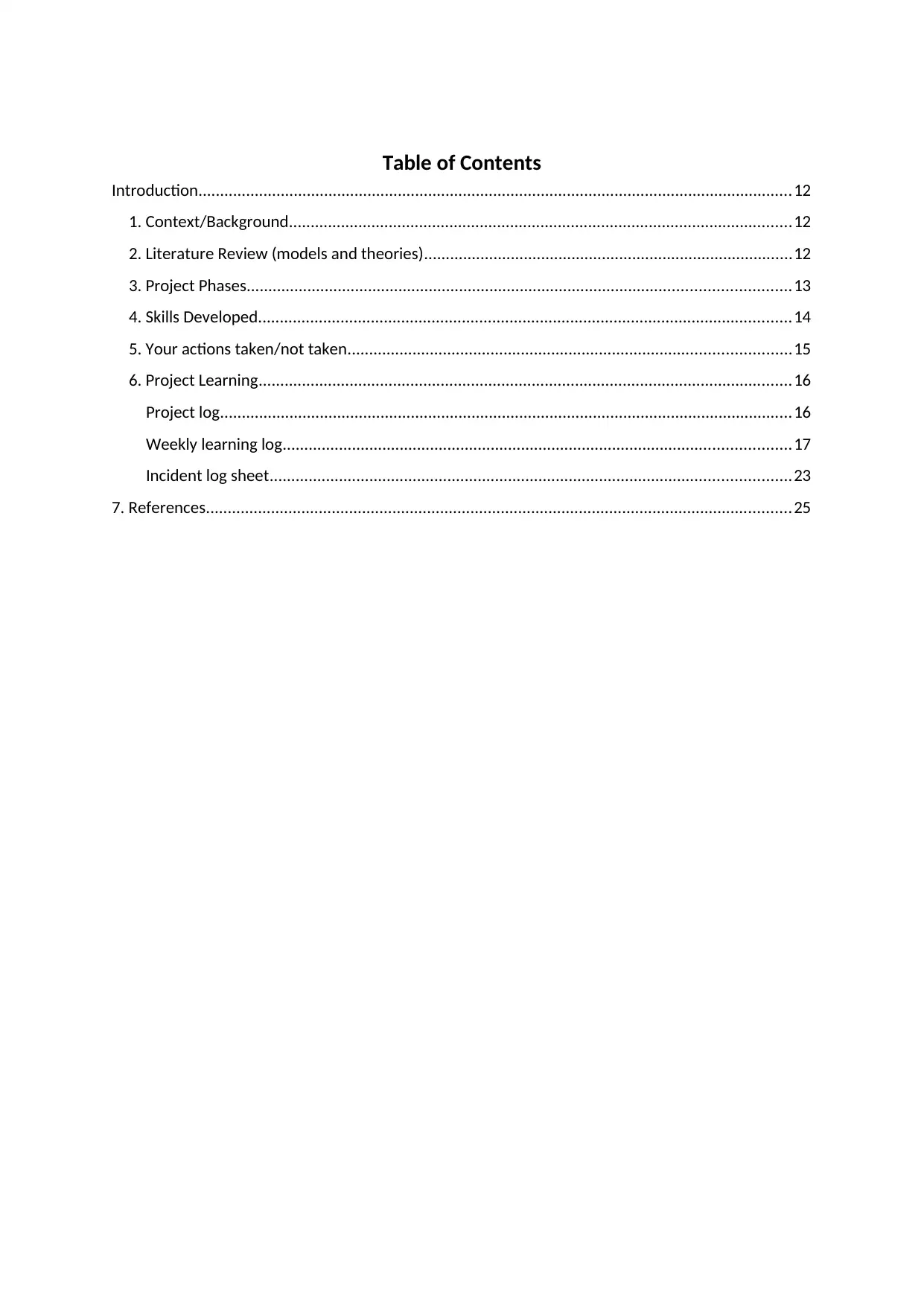
Table of Contents
Introduction.........................................................................................................................................12
1. Context/Background....................................................................................................................12
2. Literature Review (models and theories).....................................................................................12
3. Project Phases.............................................................................................................................13
4. Skills Developed...........................................................................................................................14
5. Your actions taken/not taken......................................................................................................15
6. Project Learning...........................................................................................................................16
Project log....................................................................................................................................16
Weekly learning log.....................................................................................................................17
Incident log sheet........................................................................................................................23
7. References.......................................................................................................................................25
Introduction.........................................................................................................................................12
1. Context/Background....................................................................................................................12
2. Literature Review (models and theories).....................................................................................12
3. Project Phases.............................................................................................................................13
4. Skills Developed...........................................................................................................................14
5. Your actions taken/not taken......................................................................................................15
6. Project Learning...........................................................................................................................16
Project log....................................................................................................................................16
Weekly learning log.....................................................................................................................17
Incident log sheet........................................................................................................................23
7. References.......................................................................................................................................25
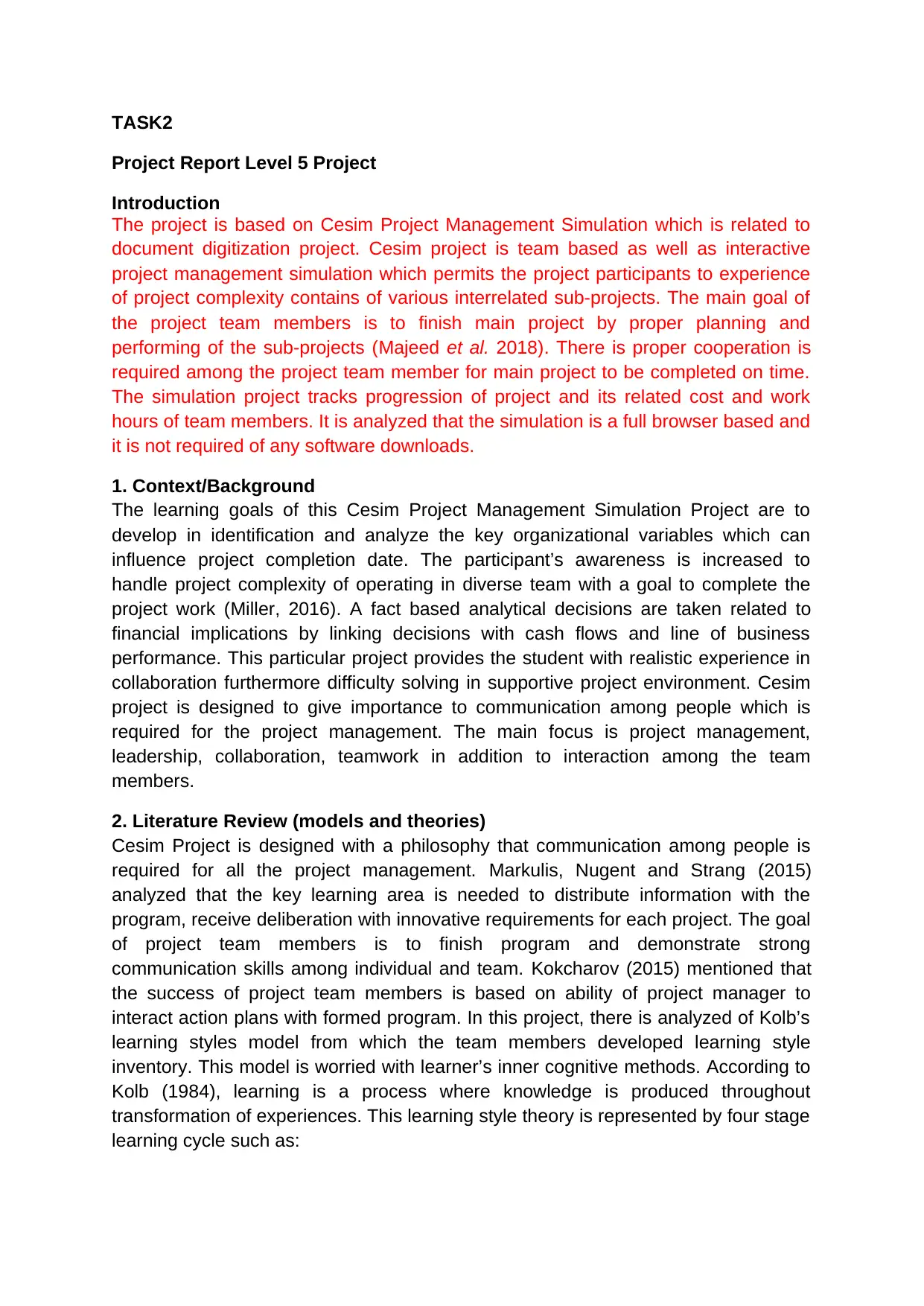
TASK2
Project Report Level 5 Project
Introduction
The project is based on Cesim Project Management Simulation which is related to
document digitization project. Cesim project is team based as well as interactive
project management simulation which permits the project participants to experience
of project complexity contains of various interrelated sub-projects. The main goal of
the project team members is to finish main project by proper planning and
performing of the sub-projects (Majeed et al. 2018). There is proper cooperation is
required among the project team member for main project to be completed on time.
The simulation project tracks progression of project and its related cost and work
hours of team members. It is analyzed that the simulation is a full browser based and
it is not required of any software downloads.
1. Context/Background
The learning goals of this Cesim Project Management Simulation Project are to
develop in identification and analyze the key organizational variables which can
influence project completion date. The participant’s awareness is increased to
handle project complexity of operating in diverse team with a goal to complete the
project work (Miller, 2016). A fact based analytical decisions are taken related to
financial implications by linking decisions with cash flows and line of business
performance. This particular project provides the student with realistic experience in
collaboration furthermore difficulty solving in supportive project environment. Cesim
project is designed to give importance to communication among people which is
required for the project management. The main focus is project management,
leadership, collaboration, teamwork in addition to interaction among the team
members.
2. Literature Review (models and theories)
Cesim Project is designed with a philosophy that communication among people is
required for all the project management. Markulis, Nugent and Strang (2015)
analyzed that the key learning area is needed to distribute information with the
program, receive deliberation with innovative requirements for each project. The goal
of project team members is to finish program and demonstrate strong
communication skills among individual and team. Kokcharov (2015) mentioned that
the success of project team members is based on ability of project manager to
interact action plans with formed program. In this project, there is analyzed of Kolb’s
learning styles model from which the team members developed learning style
inventory. This model is worried with learner’s inner cognitive methods. According to
Kolb (1984), learning is a process where knowledge is produced throughout
transformation of experiences. This learning style theory is represented by four stage
learning cycle such as:
Project Report Level 5 Project
Introduction
The project is based on Cesim Project Management Simulation which is related to
document digitization project. Cesim project is team based as well as interactive
project management simulation which permits the project participants to experience
of project complexity contains of various interrelated sub-projects. The main goal of
the project team members is to finish main project by proper planning and
performing of the sub-projects (Majeed et al. 2018). There is proper cooperation is
required among the project team member for main project to be completed on time.
The simulation project tracks progression of project and its related cost and work
hours of team members. It is analyzed that the simulation is a full browser based and
it is not required of any software downloads.
1. Context/Background
The learning goals of this Cesim Project Management Simulation Project are to
develop in identification and analyze the key organizational variables which can
influence project completion date. The participant’s awareness is increased to
handle project complexity of operating in diverse team with a goal to complete the
project work (Miller, 2016). A fact based analytical decisions are taken related to
financial implications by linking decisions with cash flows and line of business
performance. This particular project provides the student with realistic experience in
collaboration furthermore difficulty solving in supportive project environment. Cesim
project is designed to give importance to communication among people which is
required for the project management. The main focus is project management,
leadership, collaboration, teamwork in addition to interaction among the team
members.
2. Literature Review (models and theories)
Cesim Project is designed with a philosophy that communication among people is
required for all the project management. Markulis, Nugent and Strang (2015)
analyzed that the key learning area is needed to distribute information with the
program, receive deliberation with innovative requirements for each project. The goal
of project team members is to finish program and demonstrate strong
communication skills among individual and team. Kokcharov (2015) mentioned that
the success of project team members is based on ability of project manager to
interact action plans with formed program. In this project, there is analyzed of Kolb’s
learning styles model from which the team members developed learning style
inventory. This model is worried with learner’s inner cognitive methods. According to
Kolb (1984), learning is a process where knowledge is produced throughout
transformation of experiences. This learning style theory is represented by four stage
learning cycle such as:
⊘ This is a preview!⊘
Do you want full access?
Subscribe today to unlock all pages.

Trusted by 1+ million students worldwide
1 out of 26
Related Documents
Your All-in-One AI-Powered Toolkit for Academic Success.
+13062052269
info@desklib.com
Available 24*7 on WhatsApp / Email
![[object Object]](/_next/static/media/star-bottom.7253800d.svg)
Unlock your academic potential
Copyright © 2020–2025 A2Z Services. All Rights Reserved. Developed and managed by ZUCOL.




